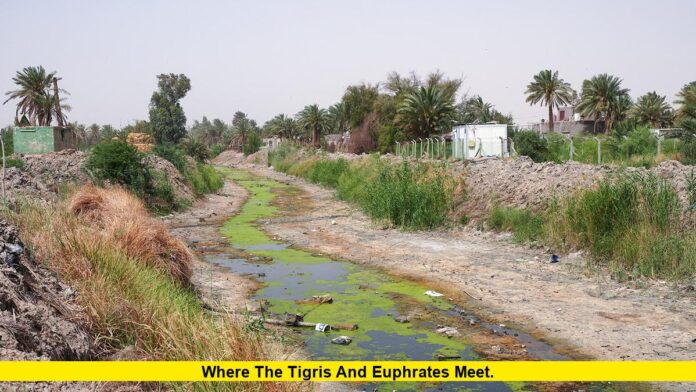The ancient land where the Tigris and Euphrates meet is experiencing its most severe water crisis in eight decades. Iraq’s water reserves have plummeted to their lowest point in 80 years, forcing the government to launch emergency initiatives to manage the dwindling resources from these historic rivers.
This confluence, which occurs at Al-Qurnah in southeastern Iraq where the two mighty rivers unite to form the Shatt al-Arab waterway, has become the epicenter of an environmental catastrophe threatening millions of lives. The region that once nurtured the cradle of civilization now faces an uncertain future as climate change and upstream dam construction dramatically reduce water flow.
Historic Low Water Levels Transform Ancient Landscape
The situation at the point where the Tigris and Euphrates meet has reached critical levels. The Iraqi government announced a new water initiative in May 2025 to manage water resources from the Tigris and Euphrates rivers as the country grapples with unprecedented drought conditions.
Agricultural communities throughout the region are witnessing their livelihoods disappear. Exposed riverbeds now mark areas that once flowed with abundant water, while the famous Mesopotamian Marshes have shrunk dramatically. Livestock deaths have surged as wetland ecosystems collapse under the pressure of sustained drought.
Farmers report that irrigation systems that sustained agriculture for millennia are failing. Traditional farming methods developed over thousands of years can no longer cope with the reduced water availability. The agricultural sector, which employs millions of Iraqis, faces potential collapse if current trends continue.
Government Response to Water Emergency
Iraqi authorities have implemented comprehensive measures to address the crisis. The new water management initiative includes digital monitoring systems and improved distribution networks. Officials emphasize that immediate action is necessary to prevent total ecosystem collapse in the region.
Emergency water rationing has begun in several provinces. Urban centers are implementing strict conservation measures while rural communities face even more severe restrictions. The government has also initiated negotiations with upstream neighbors to secure additional water releases.
International aid organizations are coordinating with Iraqi authorities to provide emergency assistance. These efforts focus on supporting communities most affected by the water shortage while developing long-term sustainability strategies.
Climate Change Accelerates Regional Crisis
Scientists point to climate change as a primary driver of the deteriorating conditions where the Tigris and Euphrates meet. Rising temperatures combined with reduced rainfall have created a perfect storm of environmental challenges.
From 2025 onward, significant portions of the country will suffer from a total drought along the Euphrates River toward the south, while the Tigris will dwindle into just a tiny watercourse with limited resources. This projection represents a dramatic shift from historical water patterns that supported civilizations for over 5,000 years.
Regional temperature increases have accelerated evaporation rates while changing precipitation patterns reduce natural water replenishment. The combination of these factors has created conditions not seen in recorded history.
Upstream Dam Construction Compounds Problems
Turkey, Syria, and Iran have constructed numerous dams along the Tigris and Euphrates river systems, significantly reducing water flow into Iraq. These infrastructure projects have altered the natural flow patterns that historically sustained the region where the Tigris and Euphrates meet.
The cumulative effect of upstream water diversions has reduced Iraq’s water supply by substantial margins. Engineering projects designed to benefit neighboring countries have inadvertently created downstream consequences that threaten regional stability.
Diplomatic efforts to negotiate water-sharing agreements have made limited progress. The complexity of balancing multiple national interests while addressing urgent humanitarian needs presents ongoing challenges for regional cooperation.
Economic and Social Implications
The water crisis extends far beyond environmental concerns. Economic disruption affects millions of people whose livelihoods depend on agriculture and fishing. Traditional industries built around river commerce face potential elimination as water levels continue declining.
Urban migration has increased as rural communities abandon farming areas. Cities already struggling with infrastructure demands now face additional population pressures from climate refugees seeking alternative employment opportunities.
Food security concerns are mounting as agricultural production declines. Iraq’s food import dependency is increasing while local production capacity diminishes, creating potential for future supply chain vulnerabilities.
International Humanitarian Concerns
International aid groups warn that the “unfolding water crisis will soon become an unprecedented catastrophe” threatening the livelihoods of over 7 million people. The scale of potential humanitarian impact has prompted increased international attention and support efforts.
Regional stability implications extend beyond Iraq’s borders. Water scarcity contributes to social tensions and could potentially influence migration patterns throughout the Middle East. International observers monitor developments closely as the crisis continues evolving.
Key Points Summary
- Iraq faces its worst water crisis in 80 years at the Tigris-Euphrates confluence
- Government launches emergency water management initiatives
- Climate change and upstream dams reduce water flow dramatically
- Over 7 million people face potential humanitarian catastrophe
- Agricultural sector collapse threatens food security
- International aid organizations coordinate emergency response
Future Outlook and Adaptation Strategies
Water management experts emphasize that sustainable solutions require comprehensive regional cooperation. Technical innovations in water conservation and distribution systems offer potential pathways forward, but implementation requires significant investment and political commitment.
Community-based adaptation strategies are emerging as local populations develop innovative approaches to water scarcity. These grassroots efforts, combined with government initiatives and international support, may provide models for addressing similar crises elsewhere.
The transformation of the landscape where the Tigris and Euphrates meet represents more than an environmental challenge—it symbolizes humanity’s broader struggle to adapt to changing climate conditions while preserving cultural heritage and supporting vulnerable populations.
Ready to learn more about how climate change affects ancient civilizations and what we can do to protect these irreplaceable cultural landscapes? Stay informed about developing environmental crises and support organizations working to address water scarcity in vulnerable regions worldwide.
